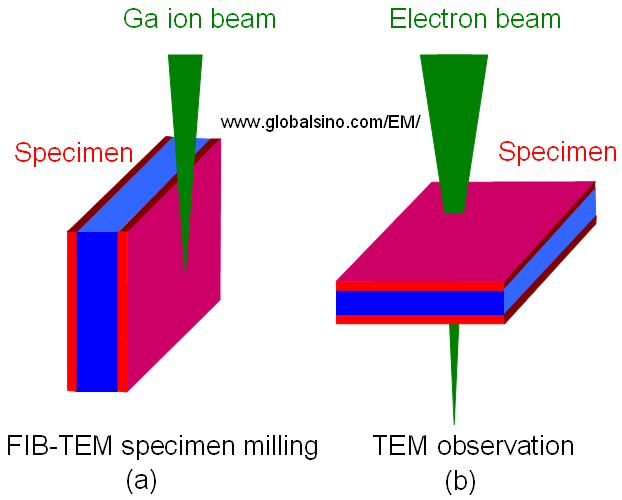=================================================================================
Energetic ions interacting with a surface can result in many microstructural or chemical modifications [1] such as grain growth, recrystallization, preferred crystallographic texture development, amorphization, and formation of additional stable or metastable phases [2 – 15]. There are many theories on how microstructure changes during FIB milling. One commonly-referenced theory is based on how specific orientations of crystals result in channeling (or minimal channeling) of incident energetic ions.
Furthermore, if a high energy Ga (gallium) beam (e.g. 30 kV) in FIB is used to prepare the specimen, a near-surface layer containing defects extends to more than 100 nm in depth other than surface amorphization. Those extended defects can trap the dopants that are present in the semiconducting region. [16 - 18]
Figure 4508 schematically shows the amorphized layers caused by FIB specimen preparation and the effects on TEM observation. If a Ga ion beam at 30 kV is used, the amorphized layer created by FIB beam will be about 23 nm into a Si film on each side of the TEM specimen. Therefore, the TEM specimen becomes entirely amorphous when its thickness is about 46 nm.

Figure 4508. Schematic illustrations of the damaged layers caused by FIB specimen preparation (a), and the effects on TEM observation (b). The unaffected layer is in blue, while the amorphized layers on both sides are in red.
To obtain high quality thin TEM-specimen, damage can be minimized in two ways:
i) Uses low energy ion milling. However, the curtaining artifacts can be worse at low kV if it occurs.
ii) Reduces
the incidence angle to the surface.
It is very important to note that FIB-induced damage is well known to be material dependent.
[1] Nastasi, M., Mayer, J.W. & Hirvonen, J.K. (1996). Ion-Solid Interactions: Fundementals and Applications. New York: Cambridge University Press, p. 176.
[2] Stroud, P.T. (1972). Ion bombardment and implantation and their application to thin films. Thin Solid Films 11, 1–26.
[3] Was, G.S. (1996). Ion beam modification of metals: Compositional and microstructural changes. Prog Surf Sci 32, 211–332.
[4] Marinov, M. & Dobrev, D. (1977). The change in the structure of vacuum-condensed hexagonal close-packed metal films on ion bombardment. Thin Solid Films 42, 265–268.
[5] Van Wyk, G.N. & Smith, H.J. (1980). Crystalline reorientation due to ion bombardment. Nucl Instrum Methods 170, 433–439.
[6] Dobrev, D. (1982). Ion-beam induced texture formation in vacuum condensed thin metal films. Thin-Solid Films 92, 41–53.
[7] Atwater, H.A., Thompson, C.V. & Smith, H.I. (1988). Ion bombardment-enhanced grain growth in germanium, silicon and gold thin films. J Appl Phys 64, 2337–2353.
[8] Atwater, H.A., Thompson, C.V. & Smith, H.I. (1988). Interface limited grain-boundary motion during ion bombardment. Phys Rev Lett 60, 112–115.
[9] Giannuzzi, L.A., Howell, P.R., Pickering, H.W. & Bitler, W.R. (1990). Diffusion induced recrystallization during ion beam milling. Scripta Met et 24, 2407–2412.
[10] Dong, L. & Srolovitz, D.J. (1999).Mechanism of texture development in ion-beam assisted deposition. Appl Phys Lett 75, 584–586.
[11] Park, C.-M. & Bain, J.A. (2002). Focused ion beam induced grain growth in magnetic materials for recording heads. J Appl Phys 91, 6830–6832.
[12] Voegeli, W., Albe, K. & Hahn, H. (2003). Simulation of grain growth in nanocrystalline nickel induced by ion irradiation. Nucl Instrum Methods Phys Res B 202, 230–235.
[13] Spolenak, R., Sauter, L.& Eberl, C. (2005). Reversible orientation based grain growth in thin metal films induced by a focused ion beam. Scripta Mater 53, 1291–1296.
[14] Spolenak, R. & Perez Prado, M.T. (2006). Single crystal like thin films by selective ion-induced grain growth. Scripta Mater 55, 103–106.
[15] Dietiker, M., Oliges, S., Schinhammer, M., Seita, M. & Spolenak, R. (2009). Texture evolution and mechanical properties of ion-irradiated Au thin films. Acta Mat 57, 4009–4021.
[16] A. C. Twitchett, R. E. Dunin-Borkowski, R. J. Hallifax, R. F. Broom, and
P. A. Midgley, Phys. Rev. Lett. 88, 238302 (2002).
[17] D. Cooper, A. C. Twitchett, P. K. Somodi, I. Farrer, D. A. Ritchie, P. A.
Midgley, and R. E. Dunin-Borkowski, Appl. Phys. Lett. 88, 063510
(2006).
[18] D. Cooper, C. Ailliot, R. Truche, J. Hartmann, J. Barnes, and F. Bertin, J.
Appl. Phys. 104, 064513 (2008).
|